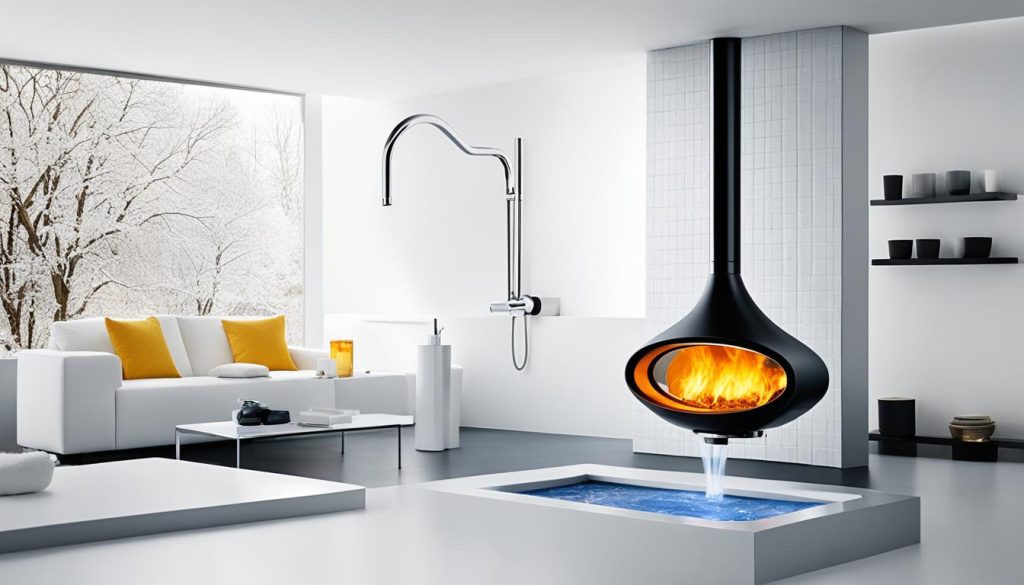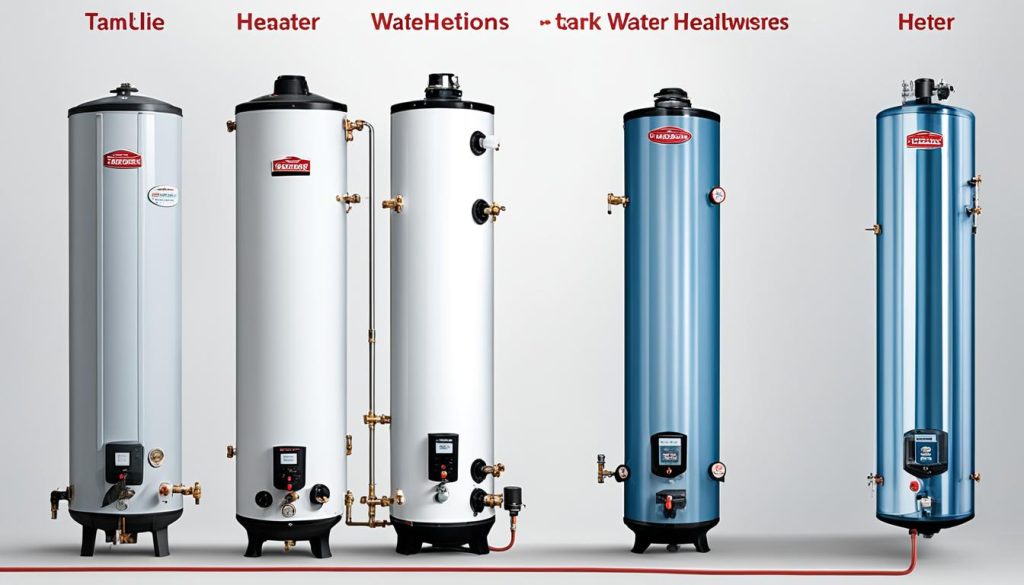Hot Water’s Rise to Commonplace: A Timeline
Did you know that hot water was once considered a luxury only accessible to the wealthy? It’s hard to imagine a time when hot water wasn’t readily available in our homes, but it wasn’t until the turn of the 20th century that running hot water became more widespread. Today, hot water is seen as a necessity in households, alongside food and shelter.
Key Takeaways:
- Hot water availability in homes has evolved over time.
- Running hot water became more widespread at the turn of the 20th century.
- Hot water is now considered a necessity in households.
- Hot water was once a luxury only accessible to the wealthy.
Early Heating Methods: From Stove to Storage Tank
In the early days, people had to rely on a variety of methods to heat and store water for their daily needs. Let’s take a look at some of the common heating methods used in the past.
1. Heating water over a fire or cooking stove
One of the earliest ways to heat water was by heating it in a pot or kettle over a fire or cooking stove. This method required manual operation and was time-consuming.
2. Water-backs and water-fronts
As running water became more readily available indoors, people started installing water-backs or water-fronts in the firebox of their stoves. This allowed for heated water to move by convection to a storage tank, providing a more convenient source of hot water.
3. Scuttle-a-day heater
Another method used to provide hot water for daily needs was the scuttle-a-day heater. This heater used coal as a fuel source to heat water. While it was an improvement over previous methods, it still required manual operation and had limitations in terms of capacity and efficiency.
These early heating methods were a significant step forward in making hot water more accessible, but they had their drawbacks. People had to invest time and effort into heating and storing water, making it less convenient compared to modern hot water systems.
Despite these challenges, these early methods laid the foundation for the evolution of hot water systems and paved the way for more efficient and convenient heating methods in the future.
Instantaneous Heating Innovation: The Bath Heater
In the late 19th century, advancements in gas and high-energy liquid fuels revolutionized hot water heating, leading to the emergence of instantaneous heating systems. One notable innovation was the introduction of the bath heater, which transformed the way people accessed hot water for bathing.
The bath heater was designed to provide quick and convenient hot water, eliminating the need for time-consuming manual heating methods. It consisted of a gas burner and a pipe loop that heated the water as it flowed through. The heated water was then sprayed over a flame, collecting heat before cascading into the tub.
This ingenious system enabled individuals to enjoy the luxury of hot water for bathing without the hassle of traditional heating methods. It marked a significant turning point in the mainstream adoption of hot water systems, making hot water a more accessible and essential resource in households.
This image showcases the ingenuity and innovation of the bath heater, providing a visual representation of how it revolutionized hot water heating during its time.
Tank-Type Heaters: Improved Efficiency and Quick Hot Water
During the early 20th century, tank-type heaters became increasingly popular as a reliable source of hot water. These heaters were equipped with storage tanks designed to heat and store water for later use, offering convenience and efficiency to homeowners.
Galvanized steel tanks were the most common material used in tank-type heaters, although copper and stainless steel tanks were also utilized. To enhance performance, insulation was added to the tanks, preventing heat loss and ensuring optimal water temperature.
In addition to the improved construction materials and insulation, tank-type heaters often incorporated innovative features to enhance heating efficiency and provide quick access to hot water. Some models featured coils of pipe in the combustion chamber, which accelerated the heating process, allowing for faster hot water production. Others had jackets around the flue, further improving heat transfer and maximizing energy efficiency.
These advancements in tank-type heaters revolutionized hot water systems, making hot water more accessible and enabling homeowners to enjoy the benefits of quick and efficient hot water on demand. As a result, tank-type heaters played a significant role in the proliferation of hot water usage, setting the stage for the widespread adoption of hot water systems we see today.
In the early 20th century, tank-type heaters marked a significant shift in hot water availability, making hot water more accessible to households. The evolution of tank-type heaters, with their improved efficiency and ability to provide quick hot water, played a crucial role in the history of hot water proliferation, further cementing hot water as a vital component of modern living.
Solar Water Heating: A Sustainable Option
During the early 20th century, the concept of solar water heating systems gained traction, offering a sustainable alternative to conventional methods. The popularity of solar water heating began to grow as individuals recognized the potential environmental and economic benefits of harnessing the power of the sun.
One of the earliest forms of solar water heating systems was the batch heater. This system consisted of tanks placed behind glass in an enclosed box. The glass allowed sunlight to penetrate, warming the water within the tanks. While this design was a step forward, it had its limitations.
To overcome these limitations, the thermosyphon system was introduced. This system improved upon the batch heater design by utilizing convection to move heated water from a collector to a storage tank. The heated water rises naturally due to its lower density, eliminating the need for additional mechanical parts. This innovation helped address some of the challenges faced by batch heaters and offered improved efficiency in solar water heating systems.
Despite the progress made in solar water heating, there were still challenges to overcome. One common issue was overnight heat loss, as the stored hot water would gradually cool down. Another concern was the potential damage caused by freezing temperatures, which could impact the components of the system.
Nevertheless, the growth in popularity of solar water heating systems continued as individuals sought more sustainable ways to meet their hot water needs. The ability to harness the power of the sun and reduce reliance on traditional heating methods appealed to environmentally conscious consumers.
In conclusion, solar water heating systems emerged as a sustainable option in the early 20th century. Although they faced challenges, the popularity of these systems continued to grow as people recognized the environmental benefits and cost savings they offered. The development of more advanced solar water heating technologies has further enhanced their efficiency and reliability.
Changing Trends: Modern Hot Water Usage
In recent decades, the widespread use of hot water has undergone significant changes in Canada. With the implementation of plumbing codes and regulations, complete plumbing facilities, including hot water, have become a standard requirement in new homes.
The choice of heating fuels has also evolved, as homeowners have moved away from coal and fuel oil towards more efficient and environmentally friendly options such as natural gas and electricity. This shift reflects the growing awareness and concern for sustainability and reducing carbon footprints.
Furthermore, there has been a notable shift in household demographics. The average number of people per household has decreased over time, while the size of new homes has increased. This change in household structure has influenced hot water usage patterns, with smaller households requiring less hot water storage and consumption.
Overall, these changing trends in hot water usage demonstrate the evolving needs and preferences of modern homeowners. As hot water becomes more accessible and efficient, it has become an essential aspect of daily life, contributing to the comfort and convenience of households across Canada.
- Investing Wisely: How Windows & Doors in Boost Property Value and Financial Health - April 24, 2025
- The Financial Impact of Personal Injuries: Why Legal Help Matters for Business Owners - April 16, 2025
- The Hidden Financial Costs of Domestic Assault: What Business Owners Need to Know - April 16, 2025














